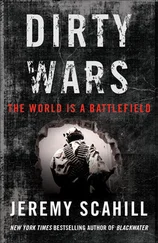Negroponte was guarded by Blackwater’s forces upon his arrival in Baghdad in June and as he stepped up the development of the largest U.S. Embassy in the world—overseeing an estimated staff of thirty-seven hundred, including twenty-five hundred security personnel, “a unit only slightly smaller than a full Marine Corps regiment.” 14In an echo of his time in Honduras, the Baghdad Embassy would house some five hundred CIA operatives. 15At the same time, Blackwater had just been awarded a vaunted diplomatic security contract worth hundreds of millions of dollars. 16But it wasn’t just American private armies that were making their mark in Iraq. In addition to the mercenary companies increasingly being employed by the occupation forces and reconstruction industry, there was also a sharp rise in death-squad-style activities in the country in the months directly following the brief joint uprising of Shiites and Sunnis in March/April 2004.
Six months after Negroponte arrived, on January 8, 2005, Newsweek reported that the United States was employing a new approach to defeating the insurgency in Iraq, one that harkened back to Negroponte’s previous dirty work two decades earlier. 17It was called “the Salvador option,” which “dates back to a still-secret strategy in the Reagan administration’s battle against the leftist guerrilla insurgency in El Salvador in the early 1980s. Then, faced with a losing war against Salvadoran rebels, the U.S. government funded or supported ‘nationalist’ forces that allegedly included so-called death squads directed to hunt down and kill rebel leaders and sympathizers.” 18The idea seemed to be that the United States would seek to use Iraqi death squads to hunt anti-occupation insurgents, while at the same time siphoning resources from the resistance and encouraging sectarian fighting. While Rumsfeld called the Newsweek report (which he admitted to not having read) “nonsense,” 19the situation on the ground painted a different picture.
By February 2005, the Wall Street Journal reported from Baghdad that about fifty-seven thousand Iraqi soldiers were operating in “planned units” that were “the result of careful preparation this summer between the U.S. and Iraqi commanders.” 20At the same time, the country saw the emergence of militias “commanded by friends and relatives of [Iraqi] cabinet officers and tribal sheiks—[they] go by names like the Defenders of Baghdad, the Special Police Commandos, the Defenders of Khadamiya and the Amarah Brigade. The new units generally have the backing of the Iraqi government and receive government funding…. Some Americans consider them a welcome addition to the fight against the insurgency—though others worry about the risks.” 21U.S. commanders referred to them as “pop-up” units and estimated they numbered fifteen thousand fighters. “I’ve begun calling them ‘Irregular Iraqi ministry-directed brigades,’” said Maj. Chris Wales, who was tasked in January 2005 with identifying the units. 22The Wall Street Journal identified at least six of these militias, one with “several thousand soldiers” lavishly armed with “rocket-propelled-grenade launchers, mortar tubes and lots of ammunition.” One militia, the “Special Police Commandos,” was founded by Gen. Adnan Thabit, who took part in the failed 1996 coup plot against Saddam Hussein. Lt. Gen. David Petraeus, who in 2005 was “overseeing the massive U.S. effort to help train and equip Iraqi military units,” told the Journal he gave Thabit’s unit funding to fix up its base and buy vehicles, ammunition, radios, and more weapons. “I decided this was a horse to back,” Petraeus said. 23
Upon his arrival in Baghdad, Negroponte joined up with other U.S. officials who were veterans of the U.S. “dirty wars” in Central America—among them Bremer’s ex-deputy, James Steele, who had been one of the key U.S. military officials managing Washington’s brutal “counterinsurgency” campaign in El Salvador in the 1980s. 24“The template for Iraq today is not Vietnam, to which it has often been compared, but El Salvador, where a right-wing government backed by the United States fought a leftist insurgency in a 12-year war beginning in 1980,” wrote journalist Peter Maass at the time in The New York Times Magazine 25:
The cost was high—more than 70,000 people were killed, most of them civilians, in a country with a population of just six million. Most of the killing and torturing was done by the army and the right-wing death squads affiliated with it. According to an Amnesty International report in 2001, violations committed by the army and its associated paramilitaries included “extrajudicial executions, other unlawful killings, ‘disappearances’ and torture…. Whole villages were targeted by the armed forces and their inhabitants massacred.” As part of President Reagan’s policy of supporting anti-Communist forces, hundreds of millions of dollars in United States aid was funneled to the Salvadoran Army, and a team of 55 Special Forces advisers, led for several years by Jim Steele, trained front-line battalions that were accused of significant human rights abuses. There are far more Americans in Iraq today—some 140,000 troops in all—than there were in El Salvador, but U.S. soldiers and officers are increasingly moving to a Salvador-style advisory role. In the process, they are backing up local forces that, like the military in El Salvador, do not shy away from violence. It is no coincidence that this new strategy is most visible in a paramilitary unit that has Steele as its main adviser; having been a key participant in the Salvador conflict, Steele knows how to organize a counterinsurgency campaign that is led by local forces. He is not the only American in Iraq with such experience: the senior U.S. adviser in the Ministry of Interior, which has operational control over the commandos, is Steve Casteel, a former top official in the Drug Enforcement Administration who spent much of his professional life immersed in the drug wars of Latin America. Casteel worked alongside local forces in Peru, Bolivia and Colombia. 26
Newsweek described the “Salvador option” in Iraq as the United States using “Special Forces teams to advise, support and possibly train Iraqi squads, most likely hand-picked Kurdish Peshmerga fighters and Shiite militiamen, to target Sunni insurgents and their sympathizers.” 27The magazine also reported that then-interim Prime Minister Ayad Allawi “is said to be among the most forthright proponents of the Salvador option.” 28This was interesting, given that the New York Times reported, “Negroponte had taken a low-key approach, choosing to remain in the shadows in deference to Ayad Allawi.” 29
Though allegations that the United States was engaged in Salvador-type operations in Iraq predate Negroponte’s tenure in Baghdad, they did seem to intensify significantly once he arrived. As early as January 2004, journalist Robert Dreyfuss reported on the existence of a covert U.S. program in Iraq that resembled “the CIA’s Phoenix assassination program in Vietnam, Latin America’s death squads or Israel’s official policy of targeted murders of Palestinian activists.” 30The United States, Dreyfuss reported, had established a $3 billion “black” fund hidden within the $87 billion Iraq appropriation approved by Congress in November 2003. The money would be used to create “a paramilitary unit manned by militiamen associated with former Iraqi exile groups. Experts say it could lead to a wave of extrajudicial killings, not only of armed rebels but of nationalists, other opponents of the U.S. occupation and thousands of civilian Baathists.” 31The former CIA chief of counterterrorism, Vincent Cannistraro, said U.S. forces in Iraq were working with key members of Saddam Hussein’s defunct intelligence apparatus. “They’re setting up little teams of Seals and Special Forces with teams of Iraqis, working with people who were former senior Iraqi intelligence people, to do these things,” Cannistraro said. 32“The big money would be for standing up an Iraqi secret police to liquidate the resistance,” said John Pike, an expert on covert military budgets. “And it has to be politically loyal to the United States.” 33
Читать дальше












